#Waka El Peru
Explore tagged Tumblr posts
Text
Prophet Muhammed was from the Americas
Prophet Muhammed was from the Americas is a necessary post to demonstrate that Maurs/ Mu’urs and Islam are indigenous to the Americas since people want to make Islam, via, the double O European Moors, as the invaders, when we know that the Dum Diversas (papal bull) of 1452 authorized Christians to take possession of Saracens (Moslem Maurs) and pagans (Hebrews) and subject them to perpetual…

View On WordPress
#Al Takwa#Hajj to Mecca#History of Islam#Holy City of Mecca#Islam in America#Kaba#Kabah#Koba#Medina#Moors#Naga-Maya#original Arabs#Origins of Islam#Prophet Muhammed#Southern Arabia#the Garden of Eden#The Kaaba#the original compass#Waka El Peru#Wakanda#Yucatan Peninsula
0 notes
Text
Aramu Muru (Quechua: Ajayru marka, Aymara: Aramumuru von iranama, ‚Hang‘ oder ‚Seite‘ und muru, ‚Schnitt‘; auch bekannt als Tor der Götter) ist ein historischer Ort im äußersten Süden des Bezirks Ilave in der peruanischen Provinz El Collao (Departement Puno). Es befindet sich nahe dem Titicacasee. Der Ort wird von Esoterikern aus aller Welt heimgesucht. Aramu Muru ist Gegenstand von New-Age-Spekulationen und Verschwörungstheorien. Die flache Steinbearbeitung ist ungefähr 7,0 m groß und mit einer T-förmigen Nische von 198 cm Höhe versehen.

Laut dem Anthropologen Charles Stanish ist Aramu Muru Gegenstand von Legenden, die er der „alternativen Literatur“ zuordnet. Er zitiert eine Website, auf der die Legende von Aramu Muru wie folgt zusammengefasst ist:
„Eine andere Legende handelt zu der Zeit, in der die spanischen Konquistadoren in Peru ankamen und Gold und wertvolle Edelsteine der Inkastämme plünderten – und ein Inkapriester des Tempels der sieben Strahlen namens Aramu Muru floh aus seinem Tempel mit einer heiligen goldenen Scheibe, bekannt als der Schlüssel der Götter der sieben Strahlen. Er versteckte sie in den Bergen von Hayu Marca. Er tauchte schließlich über der Türöffnung auf, die von schamanischen Priestern beobachtet wurde. Er zeigte ihnen den Schlüssel der Götter, und es wurde ein Ritual vollzogen, mit dem Ergebnis eines durch die goldene Scheibe initiierten magischen Ereignisses, welches das Portal öffnete, und nach der Legende strömte blaues Licht aus einem Tunnel im Inneren. Der Priester Aramu Muru übergab die goldene Scheibe einem Schamanen, verschwand durch das Portal und wurde nie wieder gesehen.“
Esoteriker verweisen auf eine kreisförmige Aussparung innerhalb der „Öffnung“ des Tors, in der ihrer Ansicht nach Platz für eine Scheibe sei.
Charles Stanish sieht die „alternative Literatur“, zu der er auch die Legende von Aramu Muru zählt, im Kontext von umfassenderen Verschwörungsanschuldigungen an die „Mainstream-Wissenschaft“. Verschwörungstheoretiker seien der Auffassung, dass die – von ihnen als „Mainstream-Wissenschaft“ bezeichnete – Wissenschaft Belege für die angeblich uralten Wurzeln der Menschheit oder den angeblichen Einfluss von Außerirdischen unterdrücken würde. Demnach würden nur wenige mutige Menschen ihre Karriere riskieren, um „diese Verschwörung ans Licht zu bringen“.
Aramu Muru wird oft mit dem Sonnentor von Tiwanaku verglichen, obwohl es keine Gemeinsamkeiten zu diesem aufweist
Ein äußerst präzise gestaltetes Portal, welches ebenfalls ins Nichts führt, findet sich bei Naupa Iglesia.
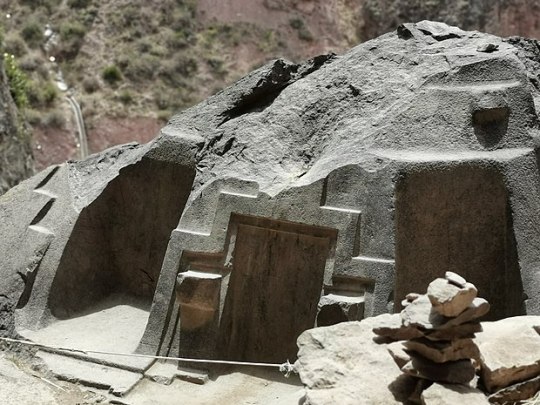
Naupa Iglesia (spanisch Iglesia ‚Kirche‘), auch Ñaupa Iglesia, Naupa Huaca, ��aupa Waka (Ñaupa für „uralt, aus früheren Zeiten“) Wak'a für „heiliger Ort oder heiliger Gegenstand“, also etwa „heiliger Ort aus früheren Zeiten“; Höhle von Choquequilla (Quechua für „Goldmond“), der goldene Mond oder Mondtempel, ist eine archäologische Stätte in der Nähe von Pachar Peru wenige Kilometer von Ollantaytambo entfernt.
Der Ort ist Pilgerstätte für Esoteriker und Gegenstand von Spekulationen verschiedenster Art.
Die Höhle liegt am Berghang über verfallenen landwirtschaftlichen Inka-Terrassen oberhalb des Río Huarocondo, fünf Kilometer südöstlich von Ollantaytambo und vierzehn Kilometer westlich von Urubamba in einer Höhe von 3627 Metern über dem Meeresspiegel. Erreichbar sind die Ruinen über eine zentrale Treppe, die die Terrassen hinaufführt.
Naupa Iglesia ist eine Höhle, deren flache Steinflächen ein umgekehrtes „V“ bilden. An einer Felswand der Höhle befindet sich ein äußerst präzise gefertigtes „Scheintor“ (englisch false doorway), das wie im Fall von Aramu Muru ins Nichts führt.
Vor der Höhle steht eine abstrakte, symmetrische, stufenförmige Skulptur aus schwarzem Granit, die allerdings stark beschädigt ist, da der obere Teil durch Schatzgräber weggesprengt wurde. Über dem Stufensymbol ist heute noch die Stelle sichtbar, wo die Sprengpatrone eingesetzt wurde.
Sie wird von einer Mauer flankiert, die aus zwei Reihen von vier Nischen eines bestimmten Typs besteht, was nach Gullberg und Malville die Bedeutung des Ortes unterstreicht. Bei den Nischen dieser Mauer handelt es sich um Nischen im Tiwanaku-Stil. Diese doppelt gerahmten Nischen sind selten in der Region Cusco anzutreffen und sie erinnern nach Jean-Pierre Protzen an ein Tiwanaku-Design. In Choquequilla gibt es zwei Variationen der doppelt gerahmten Nischen: die regulären einfachen doppelt gerahmten Nischen und die doppelt gerahmten Nischen mit äußeren abgestuften Laibungen.
Zusätzlich gibt es unmittelbar nördlich der Höhle eine kleine Gebäudestruktur mit Nischen, Türen und Fenstern im Mauerwerk.
Einige Bezeichnungen für die Stätte legen Mondzeremonien nahe. Die Skulptur aus schwarzem Granit bezeichnet Scott C. Smith als „Altar“,wohingegen Steven Gullberg und J. McKim Malville sie als „Schrein“ bezeichnen.
Nach Adam Herring (Spezialist für die Kunst des präkolumbischen Amerikas) könne die Höhle von Choquequilla möglicherweise mit der Anden-Weltanschauung t’oqo identifiziert werden; die Ahnenhöhle der Ethnogenese und dynastischen Entstehung. Laut dieser Mythologie war die Höhle ein Portal der Erscheinung der mythischen Vorfahren in die menschliche Welt. Bei den Inka war die Form des quadratischen Rahmens weit verbreitet, um den t’oqo darzustellen. Nach der Historikerin Carolyn Dean würden Stufensymbole symbolisch für den Eintritt in unterschiedliche kosmische Sphären und die Kommunikation mit den Ahnen-Wesen stehen.
Laut dem Archäoastronomen Steven Gullberg erleuchtet der Aufstieg der Sonnenwende die Höhle hell. Ebenso dramatisch könne das Licht eines aufgehenden Vollmondes wirken.

Fontainenstein „Baño de la Ñusta“ in Ollantaytambo, der Spuren eines unbekannten Werkzeugs aufweist.

"Mondtempel“ nahe Machu Picchu ebenso in einer Höhle gelegene Tore, die ins Nichts führen.
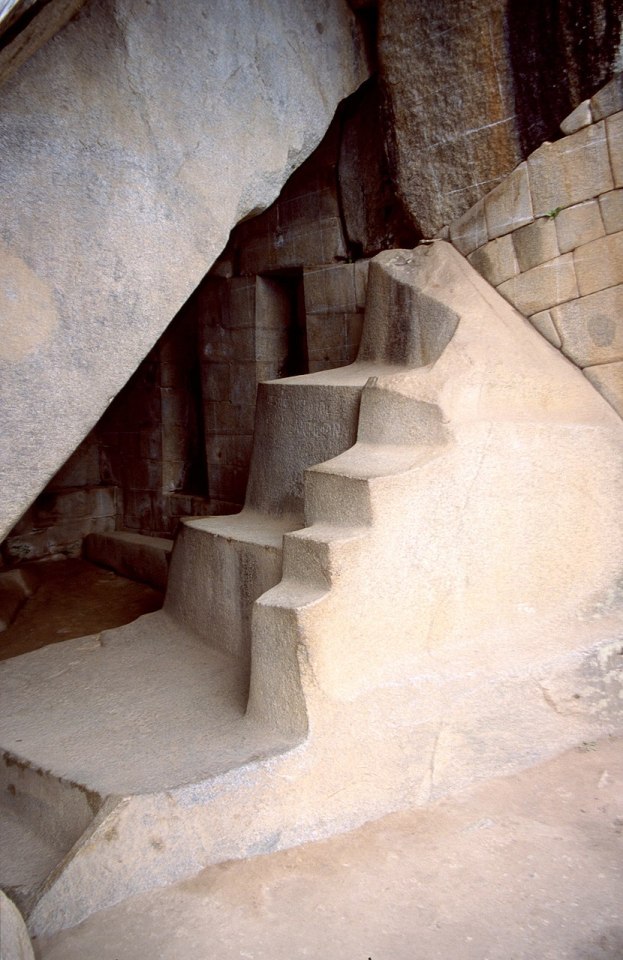
Höhle in Machu Picchu, die ebenso Tore beherbergt, die ins Nichts führen und die ebenso ein umgekehrtes „V“ bildet wie die Höhle von Naupa Iglesia und vor der sich ebenso ein Stufenmotiv befindet.

Grundriss von Ak-kapana in Tiwanaku mit Stufenmotiv, das formale Ähnlichkeit zu dem Stufenmotiv von Naupa Iglesia aufweist.

Stufenmotiv nahe Höhleneingang bei Sacsayhuamán.
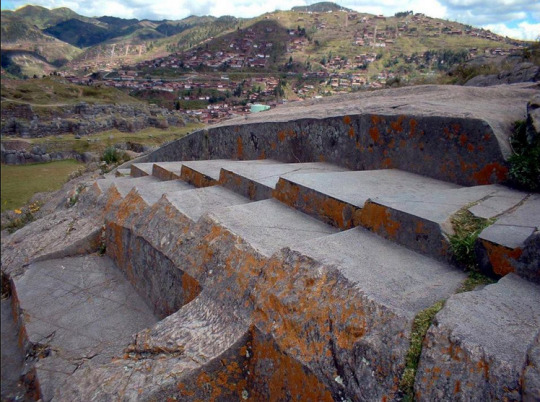
Sitzartige Ausarbeitungen in Sacsayhuamán, die denen von Naupa Iglesia ähneln.
Die Skulptur aus schwarzem Granit ähnelt derjenigen Struktur in Ollantaytambo, die auch als „Baño de la Ñusta“ bekannt ist.
Nach César Paternosto gebe es eine formale Ähnlichkeit der „Höhle von Choquequilla“ mit Tiwanaku-Architektur. Allerdings müsse diese formale Ähnlichkeit durch die herausragende konstruktive Symbolik der Inka stark infrage gestellt werden. In diesem Fall sei nach Ansicht von César Paternosto die massive trapezoide Gestalt des Monuments ausschlaggebend. Das Stufenmotiv sei in allen Kulturen des alten Amerika weit verbreitet gewesen und weit davon entfernt, exklusiv mit Tiwanaku assoziiert zu sein. Dies müsse nach Paternosto auch bei der formalen Ähnlichkeit der Mauer der sechs Monolithen mit Tiwanaku-Architektur berücksichtigt werden (siehe Mögliche ursprüngliche Errichtung durch Tiwanakaner).
Ähnliche Stufenskulpturen nahe Höhleneingängen finden sich ebenso bei Qenko und Sacsayhuamán.
Die Ruine der Inka-Festung Saqsaywaman (hispanisiert Sacsayhuamán), auch Saksaywaman ist heute eine der bedeutendsten Sehenswürdigkeiten aus der Inkazeit und liegt am Rande der peruanischen Stadt Cusco. Sie liegt etwa 3 km oberhalb des Stadtzentrums. Die Anlage sollte als Repräsentationsort dienen und als militärische Befestigung den am meisten gefährdeten Zugang zur Stadt schützen. Gegen eine Deutung als Verteidigungsanlage sprechen indessen Bauformen, die am ehesten auf Heiligtümer hinweisen, wie Nischenplätze, kreisförmige Arenen von etwa 100 m Durchmesser und ausgebaute Treppen in einzelstehenden Felsblöcken. Während der spanischen Eroberung wurde die Anlage teilweise zerstört, die Bausubstanz wurde seitdem durch Erdbeben weiter beschädigt.
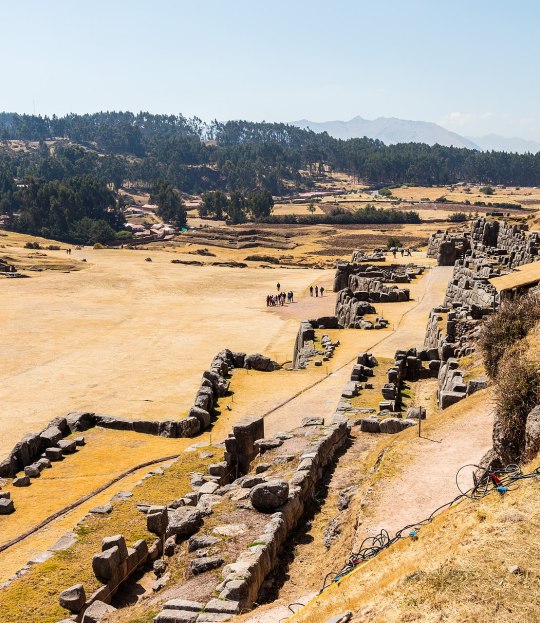
Als Erbauer der Stätte gelten die Inka Pachacútec Yupanqui und Túpac Yupanqui. Während der 70-jährigen Bauzeit in der zweiten Hälfte des 15. Jahrhunderts sollen nach Angaben von Pedro Cieza de León 20.000 Menschen daran gearbeitet haben. Die erste Beschreibung Sacsayhuamáns stammt vom Chronisten Pedro Sánchez de la Hoz (1556). Er identifizierte Sacsayhuamán als Festung und schrieb
„Diese Mauern sind das Schönste, was man unter den Gebäuden dieses Landes sehen kann, denn sie bestehen aus so großen Steinen, dass niemand, der sie sieht, sagen würde, dass sie von Menschenhand dort errichtet wurden, denn sie sind so groß wie Berg- oder Felsbrocken […] aber keiner von ihnen ist so klein, dass drei Karren sie tragen könnten. Diese Steine sind nicht flach, aber sehr gut bearbeitet und passen zusammen.“
Nachdem Francisco Pizarro Cuzco betreten hatte, beschrieb Pedro Pizarro, was sie vorfanden:
„Auf einem Hügel hatten sie [die Inka] eine sehr starke Festung, umgeben von Mauern aus Steinen und mit zwei sehr hohen runden Türmen. Und im unteren Teil dieser Mauer befanden sich Steine, die so groß und dick waren, dass es unmöglich schien Menschenhände hätten sie an Ort und Stelle setzen können ... sie waren so nah beieinander und so passgenau, dass die Spitze einer Nadel nicht in eine der Verbindungen hätte gesteckt werden können. Die gesamte Festung war in Terrassen und flachen Räumen aufgebaut.“
Der Name Saksaywaman heißt auf Quechua (Qusqu-Qullaw) „gesättigter Falke“, wobei saksay „sättigen“ und waman „Falke“ bedeutet. Die Academia Mayor de la Lengua Quechua (AMLQ) deutet den Namen jedoch als Saqsaywaman, „angespannter Falke“ (saqsa, „angespannt, gekräuselt“) oder „Falke mit gekräuseltem Kopf“ Saqsaywaman ist eine sehr häufige Quechua-Schreibung, so auch in Quechua-Lesebüchern der Region Cusco. Das Verb saksay wird im Cusco-Quechua sehr oft saqsay geschrieben, weil k und q in dieser Quechua-Variante am Silbenende durch Frikativierung wie [x] und [χ], in vielen Gegenden aber gleich gesprochen werden und so Saqsaywaman trotz dieser Schreibung als „gesättigter Falke“ oder auch „Sättige dich, Falke!“ (Saksay/Saqsay, Waman!) übersetzt wird.
Diego González Holguín nennt 1608 als Bedeutung für Çacça(y) huaman (Synonym anca) „großer Adler (Steinadler)“, was gleichzeitig der Name der Festung des Inka in Cusco sei. Er verneint die schon damals dem Namen allgemein zugesprochene Bedeutung „gesättigter Falke“.
Sacsayhuamán ist auch als Pumakopf gedeutet worden, da diese Stätte, aus der Luft gesehen, die Form eines Pumakopfes hat, wobei die Straßenzüge des alten Cusco dessen Körper bilden. Auf Grund dessen ist sogar eine Namenserklärung Saqsauma „marmorierter Kopf“ aus saqsa („marmoriert“) und uma („Kopf“) konstruiert worden.
Die wichtigste „Verteidigungslinie“ besteht aus drei zyklopischen, terrassenförmig übereinandergebauten Zickzackmauern. Sie sind 600 m lang. Die untere Mauer ist 9 m, die mittlere 10 m und die obere 5 m hoch. Zum Bau der Mauer wurden riesige Steine von den 20 km entfernten Steinbrüchen herantransportiert und dann bearbeitet, bis sie fugenlos aneinander passten. Der größte Stein ist 9 m hoch, 5 m breit, 4 m dick und wiegt über 200 Tonnen.
Oben sind die Überreste von zwei viereckigen Türmen und einem runden Turm, dem Muya Marca, zu sehen. Sie sind durch unterirdische Gänge miteinander verbunden. Die Terrassen sind von Kanälen zur Wasserversorgung und zur Ableitung von Regenwasser durchzogen. Hinter den Wällen liegt ein großer Platz, auf dem auch heute noch jährlich am 24. Juni das Sonnenfest (Inti Raymi) gefeiert wird, das auch der Präsident besucht.
Im hinteren Teil der Anlage befindet sich ein kreisrunder Platz, vertieft angelegt und gestützt durch einen mannshohen Mauerring. Daneben befinden sich ein kurzer schmaler Tunnel, der nur von einer einzelnen Person passiert werden kann, sowie verschiedene Mauerreste und eine „Rutschbahn“ im Felsen.
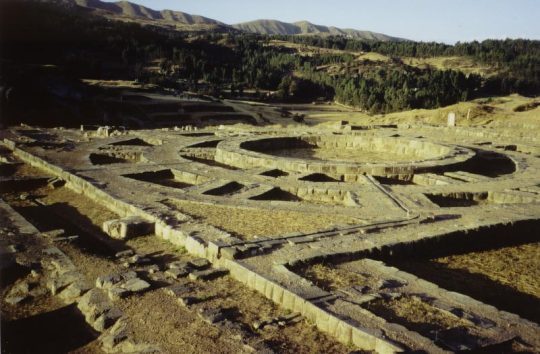
#hexe#magick#witch community#witchcraft#baby witch#witch tips#beginner witch#pagan witch#chaos magick#witchblr#inka#inkas#inca#incan#peru#lake titicaca#Cuzco#aramu muru#tiwanaku#naupa iglesia#naupa huaka#ollantaytambo#machupicchu#ak kapana#sacsayhuaman#saqsaywaman#quechua
0 notes
Link
A 1,500 year old Mayan altar discovered in a small archeological site in northern Guatemala is drawing comparisons to popular fantasy drama television series "Game of Thrones" for its descriptions of the Kaanul dynasty's political strategies aimed at bringing entire cities under its control.
The altar, carved out of limestone and weighing around one ton was found at the La Corona archeological site in the jungle region close to the borders with Mexico and Belize, Tomas Barrientos, co-director of excavations and investigations at the site told journalists.
Barrientos said the altar was found in a temple and showed King Chak Took Ich'aak, La Corona's ruler, "sitting and holding a scepter from which emerge two patron gods of the city."
According to studies, the 1.46-meter by 1.2-meter slab contains a hieroglyphic Mayan inscription corresponding to May 12, 544.
Other discoveries have allowed researchers to determine that King Chak Took Ich'aak also governed the nearby city of El Peru-Waka some 20 years later.
Barrientos says these pieces of evidence show that the Kaanul dynasty, or Serpent Kingdom, developed a political movement in La Corona that allowed them to defeat their Tikal "arch rivals" in 562 and thereafter rule the Mayan lowlands in southeast Mesoamerica for two centuries.
- 'Mayan Game of Thrones' -
That political movement was based around alliances with small cities surrounding Tikal ahead of the final victory push.
Alongside those revelations, researchers also found details of a wedding between a princess from the Serpent Kingdom and a King of La Corona, Barrientos said.
"This altar shows us a part of Guatemala's history and in this case, around 1,500 years ago, I would call this the historical Mayan version of Game of Thrones," he added, comparing the Kaanul kingdom's maneuvering to that in Game of Thrones of noble families competing over control of the seven kingdoms.
Barrientos said the altar "fills in the gaps" and "pieces together the puzzle" of the Mayan culture's political relationships.
"It's a high quality work of art that shows us they were rulers entering into a period of great power and who were allying themselves with others to compete, in this case, with Tikal."
La Corona "was the place where the most important historical Mayan political movement began to take shape."
The Serpent Kingdom expanded from its capital Dzibanche to present day north Guatemala, Belize and the Mexican state of Campeche but was finally defeated by Tikal.
- Dangerous excavations -
"Having information about what happened next, how they were plotting a political strategy here, teaches us a lot about politics in those times and the fight for territory," said Barrientos.
Excavating and investigating in the remote Mayan Biosphere Reserve where La Corona lies can be hazardous, though.
The region is constantly at threat from looting, invasions and incursions by criminal gangs, drug-traffickers and illegal ranchers, accused by environmentalists and authorities of starting forest fires that damage pre-Columbian monuments.
Culture deputy minister, Gladys Palala, told AFP that authorities are trying to counter encroachment by criminal groups besieging Peten, an area ripe with "archeological remains."
"Wherever you go and excavate, you find (something). It's an eminently archeological area," she said.
The Mayan culture reached its apogee during the classical period from 250-900 before going into decline over the next 300 years.
#archaeology#arqueologia#maya#mesoamerica#guatemala#history#historia#game of thrones#tikal#la corona#el peru-waka#el peru waka
62 notes
·
View notes
Photo



Maya ceramic figurines, Waka (El Peru), Guatemala AD 656
375 notes
·
View notes
Photo
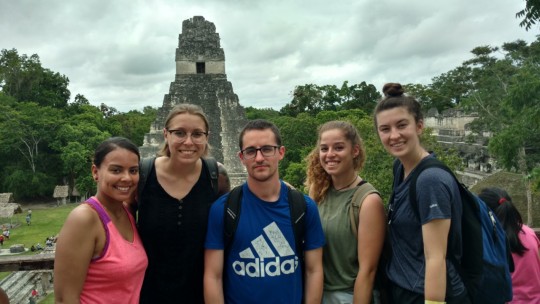



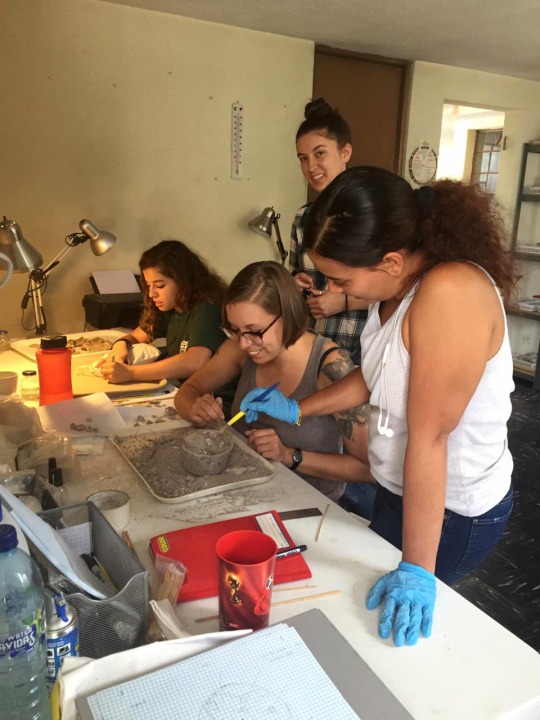


Uncovering a Mayan mystery
A summertime dream destination for many is Disneyland. For archaeologists and adventurers alike, their dreams lay hidden deep in the jungles of Guatemala. This past summer, Bloomsburg University student Arianna Ambrosio joined the few given an opportunity to achieve such a dream.
Working under Bloomsburg University anthropology professor Damien Marken and Guatemalan archaeologist Damaris Menendez, a discoverer of the ancient Royal Snake Lord Tomb, the anthropology major spent her summer excavating an ancient Maya household in archeologists’ goldmine of El Peru-Waka’, Peten Guatemala.
Although leaving family and the norms of everyday life behind to live in tent houses buried in remote jungles for months was a daunting suggestion, Ambrosio was confident it would all be worth it in the end. After taking a class on the Aztecs and Maya, her interest in that region of the world had peaked and nothing short of experiencing it herself would satisfy that itch.
From the first day she arrived, Ambrosio was fully immersed in Guatemalan life.
“Living in the jungle was definitely the best, the strangest, and most challenging all at once,” Ambrosio said.
“I loved waking up every day to the loud sounds and wildlife of the jungle, and seeing monkeys in the trees on my 20-minute hike to work every day, even the creepy crawlies like the tarantula that liked to hangout outside my tent or the lizards that would run away from me on my way to the bathroom,” she recalled.
During her time in Guatemala, Ambrosio said she “worked with local workers and got to learn from them not only about the archeology, but about the jungle and the local culture, which is everything to an anthropologist.”
The anthropology student said “there were the expected stares of being a foreigner and the language barrier, but that wasn’t so bad. I almost liked experiencing all these new things at once from an outsider’s perspective, but I learned quickly how some things never change cross culturally
Ambrosio said that during the time she spent in the jungle, “I became friends with local Guatemalans and learned so much Spanish.”
“Being Hispanic, it meant the world to connect with that side of my own heritage.”
When she wasn’t working, Ambrosio was using her time off to sight-see and indulge her hunger of curiosity.
“I loved being able to visit other sites and learn from other professionals in the field while seeing beautiful architecture and structures that were thousands of years old,” she said.
“Visiting other parts of the country on our days off was so valuable to me, I loved being able to see Tikal most of all.” Tikal is an ancient Maya citadel that was once one of the most powerful kingdoms of an ancient empire.
Ambrosio said, “I was able to experience so many beautiful ruins in the country and was able to learn about the archeological community.”
She was even given the chance to visit Naranjo, a place she described as “a hidden gem in the jungle that contains an intricately reconstructed palace that you can climb on and experience without limitations, including a view of the jungle top that was incredible.”
After being given the opportunity to explore and experience the life of an archaeologist, Ambrosio has clarity in what she wants to do after Bloomsburg University.
The anthropology major said that the trip “gave me the means of knowing where to point my career and how to do it. I also learned a plethora of different specializations within the field of archeology that I could potentially point my interest in. Most of all, it taught me so much about archeology and gave me the possibility and flexibility to pursue archeology as a career full time.”
Ambrosio stated “the experience gave me everything I needed to excel in archeology, not only at Bloomsburg University, but to get involved with the professional world. Not only did it give me enthusiasm for my future in archeology, it showed me what it’s going to take to pursue this career and where I can end up in the future.”
Overall, she determined that “there are some things you can’t understand about a place until you have fully dedicated and immersed yourself into the culture and the area.”
Ambrosio’s summer trip to Guatemala put her in a world unlike anything she had ever experienced and pulled her away from everything she had ever gotten used to, but she says “I’ve come to realize the opportunities and experience I have had and will have make everything worth it.”
The data collected by Arianna Ambrosio over the summer will be used by the Waka’ Archaeological Project in junction with National Geographic to reorganize the chronology of the Mayan development.
— Kelsey Jones, physics major
Summer 2019 (May-August)
Damien Marken continued his research as director of the Waka' Archaeological Project (PAW) in Guatemala. Accompanying him in the jungle doing fieldwork this summer were two Bloomsburg URSCA recipients, Arianna Ambrosio and Bailey Gemberling, as well as alum Zac Cooper '16. Ambrosio assisted Marken and Guatemalan archaeologist Damaris Menendez excavating a household of crafting artisans in the hinterlands of the ancient Maya city of El Peru-Waka', Peten, Guatemala, while Gemberling and Cooper continued the ground verification of a recent LiDAR survey of the region.
Following the May-June field season, two additional BU students, Abigail Cruz and Andrew Miller, and another alum, Emily Haney '18, now a master’s student in archaeology at Brandeis University, joined the team in the PAW lab house in Guatemala City along with graduate students from Tulane University and Yale University and faculty from Tyler Junior College in Texas, the College of Wooster in Ohio, and the Dallas Museum of Art.
There the students were trained in the analysis of archaeological ceramics and completed a massive addition to the PAW ceramic database. Not only will these data be invaluable for PAW researchers reconstructing the occupational chronology and economic organization of the ancient city, they will also serve as the basis for presentations and future research by the students themselves.
1 note
·
View note
Photo
@bogleech
How about this article?
https://unframed.lacma.org/2017/09/21/archaeology-el-%C3%BA-waka%E2%80%99-maya-ritual-resurrection-scene-broader-perspective
There are tonnes of other awesome figures from El Peru-Waka also.
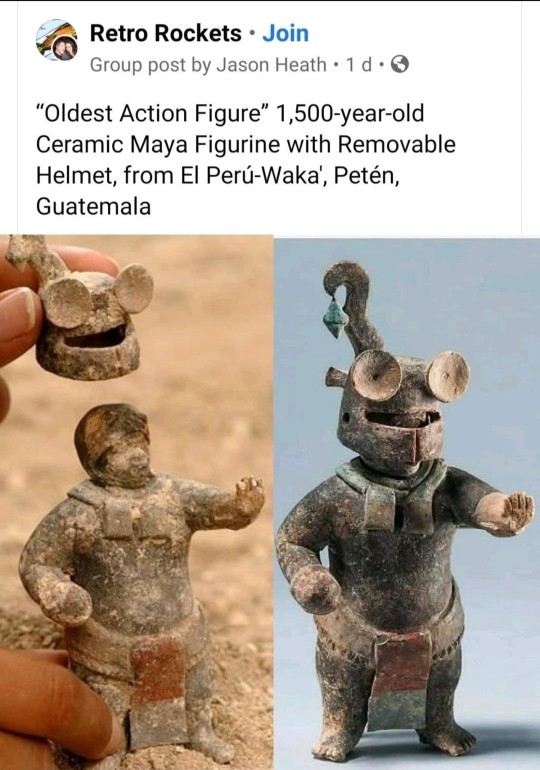
109K notes
·
View notes
Photo

1,500-year-old Ceramic Maya Figurine with Removable Helmet, from El Peru-Waka', Peten, Guatemala. It's a chunky man trying his best, I am utterly enamoured.... Do you have an opinion on this? Share it! HERE -> https://worldnewsinpictures.com/1-500-year-old-ceramic-maya-figurine-with-removable-helmet-from-el-peru-waka-peten-guatemala Ceramic CeramicMaya CeramicMayaFigurine Helmet HelmetPeruWaka HelmetPeruWakaPeten Figurine Removable #Ceramic #CeramicMaya #CeramicMayaFigurine #Helmet #HelmetPeruWaka #HelmetPeruWakaPeten #ItsShare #ItsShareHERE #CeramicMayaCeramicMayaFigurine #CeramicMayaCeramicMayaFigurineHelmet #HelmetPeruWakaPetenFigurine #HelmetPeruWakaPetenFigurineRemovable #Figurine #Removable
0 notes
Photo

¡FELIZ QAPAQ RAYMI! - THAYANA URUPA El 21 de diciembre se inicia el solsticio de verano para el hemisferio sur, tiempo en el cual el Sol se aproxima más a nosotros, tornándose vecino a la Chakana (Cruz del Sur). Con esto empieza nuestra estación de verano, por la cual los rayos solares llegan perpendicularmente al trópico de Capricornio llegando con mayor intensidad, evaporando las aguas y superficies húmedas que al llegar a cierta altitud se condensan para precipitarse y complementar la faena agrícola. Nuestros pueblos andino amazónicos festejaban ancestralmente a este fenómeno como el Qapaq Inti Raymi o Gran Fiesta del Sol. - Otros pueblos relacionaban al elemento viento. Según el cronista Waman Poma de Ayala en su “Nueva crónica y buen gobierno”: “…en este mes de diciembre Qapaq Inti Raymi -mes de fiesta del sol es el mes de sembrar papas, uqas, quinua, trigo. También quchqa sara (temporal), con lluvia. Si pasa este mes, se pierde la sementera porque llueve hasta marzo, no se anda en el reino. No andan los mercachifles de vino, coca, ají, sal, harina, maíz ni ropa. Aparecen las frutas: melones, lúcumas, paltas, durazno en el reino…” a la que había que agregar la floración de las orquídeas y la aparición de las moras. Todos los que buscamos armonizar la vida, empezamos a caminar por el reencuentro y armonía con nuestra Pachamama y a celebrar el Gran Qapaq Raymi el 21 de diciembre. Caminamos por un día completo, siempre acompañados por estrellas brillantes, la Mama Killa (madre luna) -que en este año ha tocado luna nueva el mismo día-, el Wayra (viento), el Llullu tamya (lluvia tierna), el Inti Yaya (padre sol) y por runas (seres humanos) que moran de lo más simple y complejo y maravilloso suelo andino, a lo largo del camino, hasta las Wakas sagradas. Fuente: http://compartiendoculturas.blogspot.com.ar/2010/12/el-qapaq-inti-raymi.html (en Miculla, Tacna, Peru) https://www.instagram.com/p/B6Vidq4FLuv/?igshid=m1xd98v54sm0
0 notes
Text
Sucesso de arrecadação: o impacto financeiro das turnês de Shakira
Shakira esteve entre as turnês mais lucrativas em todos os anos em que rodou o planeta com uma série de shows
Faltam pouco menos de 40 dias para Shakira dar início à sua nova série de shows, que vai rodar o mundo até o final do ano. Prevista para começar na Alemanha no início de junho, a El Dorado World Tour já tem 38 datas agendadas na Europa e América do Norte. Mais datas serão adicionadas ao cronograma da turnê, que ainda vai incluir uma passagem pela América Latina, por países como México, Colômbia, Equador, Peru, Chile, Argentina, Uruguai e Brasil. Com ingressos na Europa chegando à casa dos € 200 e nos EUA à cifra dos US$ 2 mil nos chamados pacotes vip, a expectativa é que os cofres de Shakira e da Live Nation, a promotora da turnê, engordem em muitos milhões de dólares. Ainda é cedo para qualquer previsão de arrecadação, mas desde que se transformou em uma estrela global, todas as turnês da colombiana estiveram entre as mais lucrativas em seus respectivos anos. E, ao que tudo indica, com a El Dorado World Tour não vai ser diferente. O Shakira Brasil obteve acesso aos dados de desempenho das turnês anteriores da artista, reportados pela empresa de gerenciamento de informações Pollstar, e os números são mesmo impressionantes.
Tour Sale el Sol: 7 ª turnê feminina mais exitosa de 2011
Embalada pelo hit da Copa da África do Sul, Waka Waka, e pelos sucessos de seus dois álbuns She Wolf (2009) e Sale el Sol (2010), a colombiana rodou o mundo com a sua The Sun Comes Out Tour nos anos de 2010 e 2011. Só em 2011 foram 51 shows em 48 cidades da América Latina, Ásia, África e Europa. Segundo a Pollstar, a série de shows de Shakira foi a 7ª turnê feminina que mais arrecadou naquele ano, com impressionantes US$ 53,2 milhões de dólares. No ranking geral, foi a 20ª turnê mais bem sucedida, à frente de nomes como Kylie Minogue, Kanye West e Jay-Z, Celine Dion, Enrique Iglesias e Pearl Jeam.
O show de Shakira na cidade de São Paulo ficou entre os 100 eventos musicais que mais arrecadaram em bilheteria no mundo todo. Foram mais de R$ 7 milhões, algo em torno de US$ 4 milhões na época, com um total de 45,117 ingressos vendidos e uma plateia que excedeu os 50 mil espectadores. O The Pop Festival na capital paulista foi o 69º concerto que mais arrecadou em 2011. Na América do Norte, Shakira aparece três vezes na lista dos 200 concertos que mais arrecadaram naquele ano. Seus dois shows em Porto Rico (contam como evento único) renderam US$ 2,859,153 , seu show em Monterrey no México US$1,865,124 e, por fim, seu concerto em Cancún gerou a cifra de US$1,850,215.
Apesar de ter feito um número menor de shows em 2010, Shakira também foi destaque naquele ano. Com suas 24 apresentações nos EUA, a cantora encheu os cofres de sua produtora em quase US$17 milhões, sendo a 40ª turnê norte-americana mais bem-sucedida, a frente de Iron Maiden, Alicia Keys e Kings of Leon. Ao todo, estima-se que a turnê Sale el Sol arrecadou mais de 100 milhões de dólares.
Oral Fixation Tour: 2ª turnê feminina que mais vendeu ingressos em 2006
Com dois singles mundiais que romperam todos os recordes, Shakira ingressou em 2006 com uma extensa turnê pelo mundo. Hips Don’t Lie foi o single mais exitoso daquele ano, de acordo com a United World Charts (UWC), e se tornou a música mais vendida da década. No ano anterior, La Tortura, mesmo sendo toda em espanhol, foi a 5ª música mais vendida do planeta, colocando Shakira como a única artista daquela década a ter singles em dois idiomas na lista dos mais bem sucedidos. O sucesso comercial dos álbuns Fijación Oral 1 e Oral Fixation 2 impactou diretamente no interesse dos espectadores globais pelos atos ao vivo da colombiana. Em 2006, sua turnê foi a segunda, por uma intérprete feminina, que mais vendeu ingressos ao redor do globo. Foram 807,838 bilhetes vendidos naquele ano, reportou a Pollstar em seu relatório anual, ficando atrás apenas de Madonna, que registrou 1,209,618.
Naquele ano, a empresa ainda não gerava o ranking de arrecadação global, apenas ranqueava as turnês mais exitosas na América do Norte. Na região, Shakira teve a 15ª melhor turnê. Seus 41 shows renderam a cifra de US$ 38,6 milhões. Quando consideramos apenas artistas femininas, ela sobe para a 3ª posição. Os concertos de Shakira na Cidade do México foram o 15º maior evento isolado de 2006, no mundo. Juntos, os 8 shows no Palacio de Los Deportes renderam US$ 7,934,021
Em 2007, mesmo com apenas 10 shows registrados na América do Norte (México), a cantora ficou entre as 100 turnês mais exitosas, com US$ 11,3 milhões em faturamento. Naquele ano, ela foi a 56ª turnê que mais vendeu ingressos, figurando dois anos seguidos entre as séries de concertos mais exitosos do planeta. Foram 324, 787 ingressos vendidos, que somados aos tíquetes do ano anterior ultrapassam a marca de 1 milhão de bilhetes. Ao todo, estima-se que a série de shows de Shakira tenha arrecadado U$S 107 milhões.
Tour of The Mangoose: A primeira turnê mundial de Shakira
Após se lançar no mercado anglo-saxão em 2001, com um álbum majoritariamente em inglês, Shakira viu sua música ultrapassar fronteiras, até então, intransponíveis. Seus hits Whenever, Wherever e Underneath Your Clothes foram, respectivamente, a primeira e a quinta músicas mais vendidas no mundo em 2002. Seu álbum, Laundry Service, foi o 7º naquele ano no planeta e o 11º mais exitoso nos EUA, de acordo com a Billboard. Com um impacto global sem precedentes, a colombiana estava pronta para ingressar em sua primeira grande turnê mundial. A Turnê do Mangusto rodou diversas cidades da Europa, EUA e América Latina, nos anos de 2002 e 2003.
Em 2002, com apenas 14 concertos realizados nos EUA, a cantora teve a 56ª melhor turnê da América do Norte, arrecadando 8,9 milhões de dólares. No ano seguinte, com apenas três concertos a mais no continente em relação a 2002, ela saltou para a posição 42 no ranking de 2003 da Pollstar. Shakira faturou US$ 14,7 milhões com seus 17 shows nos EUA e no México. Ao todo, estima-se que a turnê rendeu mais de US$ 72 milhões à Artist Group International, a promotora da série de concertos da cantora à época.
Com o retrospecto de Shakira em suas turnês anteriores e a taxa de ocupação das arenas superior a 90%, reportada pela Ticketmaster, não resta dúvidas que a El Dorado World Tour será uma das turnês mais exitosas de 2018. Ciente de que vai engordar sua conta bancária em alguns milhões de dólares, a colombiana até criou uma empresa na Espanha exclusivamente para gerenciar os dividendos da turnê, a Global Golden Tour S.L. A expectativa é que a cantora passe pelo Brasil no final de outubro e, mais uma vez, o show de São Paulo, pode vir a ser o maior em arrecadação da sua turnê, colocando o Brasil como a galinha dos ovos de ouro para Shakira e a Live Nation, sua atual produtora.
0 notes
Text
valek100 replied to your photo “WAKA (EL PERÚ) In about 656, King Jaguar Throne, a Snake ally, was...”
Are you sure of the information you give? Because these figurines are too similar to those found on the Island of Jaina, in Campeche Mexico, an artificial island used by the Maya as a cemetery. There were hundreds of figures, like the ones in the photo, that accompanied the dignitaries buried there. Even the names you give are Mayan and nothing to do with Peruvian cultures.
El Peru doesn’t refer to the modern country of Peru, but is the name of a Maya site in Guatemala which is also known as Waka. The site dates from the pre-Classic to Classic periods, around 500 BC - 700 AD, and is located west of the larger city-state of Tikal with which it was once allied.

2 notes
·
View notes
Photo

An anthropological path to academic success
The prize “fossils” that Emily Haney brought home with gritty, dirty hands when she was a child do not compare to the fragile, priceless treasures that she carefully cupped in her hands while in the steamy jungles of Guatemala.
During the summers of her undergrad career at Bloomsburg University she excavated ceramic vessels from elite households in the ancient Maya city of El Peru-Waka'. Analyzing those artifacts in the lab in Guatemala City culminated in the anthropological dreams of a university research student.
The faculty in the anthropology department, especially Damien Marken, Ph.D. played a large part in this successful BU experience. Haney’s appearance on the dean’s list throughout her academic years enabled eligibility for honors and awards that propelled her forward into her graduate program at Brandeis University in Massachusetts. Being a member of BU’s Honor Society of Phi Kappa Phi, selected as an intern for the Harrisburg Internship Semester (THIS) and as a BU nominee for the Ali-Zaidi Award of Academic Excellence was not enough. Haney went on to be named the recipient of the prestigious Lambda Alpha National Anthropology Honor Society Scholarship Award.

What started in small grants as funding for the research project in Guatemala, soon blossomed into the support of the above-mentioned awards. Bloomsburg University added to her professional career as a student researcher in Guatemala by awarding Haney an Undergraduate Research Scholarship and Creative Activities Award (URSCA).
“Although field work is tough and living in the jungle can be intimidating at times, being a part of an excavation is an unparalleled experience that makes all the hardships seem trivial.” Yet her time in the field has contributed to skills vital to archaeological excavations. It is easy to envision the shine in her eyes when she speaks of the grinding work, “I aided in the excavations of an elite residential complex known as the Chok group,” said Haney.
While in the lab, she also analyzed and reconstructed a cache of funerary vessels from the excavations. Working with the artifacts gave Haney a “surreal connection, to think that when I place my thumb in a decorative indentation on a ceramic vessel, the indentation was once occupied by a thumb of an ancient Maya potter, or when I hold a polychrome vessel, it may have once been used by royalty.”
All of that digging in the dirt, from childhood to present has culminated in many research projects where she has disseminated her findings at national conferences including the Society for American Archaeology (SAA), and the Society for Applied Anthropology (SfAA). Her accrued research through the Waka’ Archaeological Project has gained her material for posters, and presentations, not to mention co-authorships on governmental reports concerning “the documentation of social differences across the residential portions of the ancient Maya city,” said Haney.
Haney aspires to an M.A. in museum anthropology and eventually a doctorate in anthropology/archaeology to fulfill her dream of “teaching at a college level, as well as work as a museum curator,” said Haney. The education she received at Bloomsburg University was not all academic. Being a shy person meant not having the confidence to “put herself out there and really go for things,” she says. What she acquired from the support of her professors and the experiences at BU helped her “gain confidence in both myself and my abilities as an aspiring anthropologist.”
Exiting as a well-rounded undergrad of BU through excellent academics and life experiences has created a grand entrance into the professional world. Haney has the ability to achieve her dream of being an “archaeologist who conducts field and lab research, inspire the next generation of anthropologists through teaching, and is able to connect with the public through museum curation.”
— Patsy VanDyke, anthropology major and emergent media minor
#HuskyUnleashed#LiberalArts#CollaborativeLearning#anthropology#research#HuskyAbroad#MuseumAnthropology#URSCA#archaeology
0 notes
Text
Congreso Mágico de Estados Unidos de América Latina
Congreso Mágico de Estados Unidos de América Latina
Magical Congress of United States of Latin America ( shorten COMAEUAL) is the magical body in charge of governing the wizarding population of the United States of Latin America. The geographic coverage is central America including Mexico, Guatemala, Honduras, El Salvador, Belize, Haiti, Nicaragua, Costa Rica, Panama, Cuba and Dominican Republic in non-Magic world.

It is led by the President of the Magical Congress of the United States of Latin America. The congress is comprised of representatives from different states. The States are often times referred as city-states. Beneath city-states, there are sub-city-states for cities with fewer population. These are known city and sub-city states so far.
El Baúl Escuintla Department, Guatemala Becan Campeche, Mexico Calakmul Campeche, Mexico Caracol Cayo District, Belize El Ceibal (also known as Seibal) Petén Department, Guatemala Chichen Itza Yucatán, Mexico Chunchucmil Yucatán, Mexico Coba Quintana Roo, Mexico Copán Copán Department, Honduras Dos Pilas Petén Department, Guatemala Dzibilchaltun Yucatán, Mexico Iximche Chimaltenango Department, Guatemala Ixkun Petén Department, Guatemala Kaminaljuyu Guatemala Department, Guatemala Mayapan Yucatán, Mexico El Mirador Petén Department, Guatemala Naachtun Petén Department, Guatemala Nakbe Petén Department, Guatemala Naranjo Petén Department, Guatemala Oxkintok Yucatán, Mexico Palenque Chiapas, Mexico El Peru (also known as Waka') Petén Department, Guatemala Piedras Negras Petén Department, Guatemala Quiriguá Izabal Department, Guatemala Q'umarkaj Quiché Department, Guatemala San Bartolo Petén Department, Guatemala Tikal Petén Department, Guatemala Tulum Quintana Roo, Mexico Uxmal Yucatán, Mexico Yaxchilan Chiapas, Mexico Yaxha Petén Department, Guatemala
The COMAEUAL is located within the Palacio Nacional on Mexico City's main square and has hundreds of stories.

0 notes
Link

MAYA HUB An ancient Maya site called La Corona (shown in this artist’s illustration with a ceremonial center in the foreground) was a remote but key part of a large Classic Maya state, new research suggests.
New insights into an ancient Maya kingdom are coming from a remote outpost in the Guatemalan jungle.
Aerial laser maps, excavations and stone-slab hieroglyphics indicate that La Corona, a largely rural settlement, became a key part of a far-ranging Classic-era Maya kingdom that incorporated sites from southern Mexico to Central America, researchers reported on April 15 at the annual meeting of the Society for American Archaeology. Classic Maya civilization lasted from around 250 to 900.
A dynasty of Kaanul rulers, also called Snake Kings, expanded their domain from their home city of Calakmul in Mexico by using La Corona as a relay center for precious stones and other goods from Kaanul-controlled sites farther south, said archaeologist Marcello Canuto.
“Our work supports the idea that the ancient Maya formed interconnected political systems, not largely separate city-states as traditionally thought,” said Canuto, of Tulane University in New Orleans, who codirects the La Corona excavation.
Laser mapping in 2016 covered more than 2,100 square kilometers of the Guatemalan lowlands containing many ancient Maya sites. A small plane equipped with light detection and ranging equipment, or lidar, used laser pulses to gather data on the shape of the ground covered by trees and vegetation (SN: 7/23/16, p. 9). Lidar findings often guide investigators to previously unrecognized remains of past settlements.
Lidar evidence showed that a small, heavily populated core area at La Corona had existed within a large, sparsely populated rural expanse. Canuto estimates that between 2 million and 3 million people crowded into La Corona during its Classic-era heyday.

SPRAWL SCENE A lidar map portrays population densities at La Corona and nearby Classic Maya sites. Red denotes areas with the greatest number of inhabitants. La Corona and sites such as El Peru-Waka’ and Holmul were incorporated into a kingdom that conquered powerful Tikal in 562.
That population bulge at La Corona corresponded to a period from 520 to 740 when Kaanul kings transformed a series of Guatemalan sites into satellites of a state with Calakmul as the capital, said archaeologist Tomás Barrientos of the University of the Valley of Guatemala in Guatemala City. Barrientos codirects La Corona excavations with Canuto.
Although subordinate to Calakmul, La Corona’s remote location may have enabled it to maintain some political independence, Canuto proposed. But little is known about how Kaanul kings ran their state.
Key clues to Calakmul’s rule over La Corona come from stone monuments covered with hieroglyphics at the latter site (SN: 10/8/05, p. 227). Stone inscriptions at La Corona dating to 314, about two centuries before Kaanul rule, describe the arrival of specific Maya gods. La Corona’s local rulers associated themselves closely with those deities. Mention of these same gods appears on a carved monument from 546 describing La Corona as being under the control of a large capital city. Local leaders installed by rulers from the capital city, likely Calakmul, must have wanted to associate themselves publicly with revered La Corona gods, Barrientos said.
“To create a new state, Kaanul rulers manipulated traditional mythology at La Corona and celebrated their connections to deities that had preceded their arrival,” Barrientos proposed. These celebrations included ritual feasts, he said. Remains of feasts from the Kaanul era, including bones from butchered animals, have been excavated in stone pits situated in a La Corona ceremonial plaza.
Specific references to the northern capital appear more than a century later at La Corona in written records of Calakmul royal ceremonies and a local nobleman’s transformation into a ruler under the supervision of Calakmul’s king.
Considering its small area, La Corona’s population center contains a surprising amount of writing on carved stones, said epigrapher Simon Martin of the University of Pennsylvania Museum of Archaeology and Anthropology in Philadelphia. Martin, who studies Maya hieroglyphics, is not a member of the La Corona excavation team. That extensive writing and record keeping indicates that La Corona played an important role in the Kaanul state, Martin said. “So much text at such a small site suggests La Corona served as a conduit for sending goods north to Calakmul.”
Citations
M. Canuto and Luke Auld-Thomas. Preliminary LIDAR-based analyses of the La Corona – El Achiotal corridor. Annual meeting of the Society for American Archaeology. April 15, 2018, Washington, D.C.
T. Barrientos et al. Charismatic and religious aspects of Maya rulership: An interpretation of the Coranitas temple complex of La Corona. Annual meeting of the Society for American Archaeology. April 15, 2018, Washington, D.C.
Further Reading
B. Bower. Lidar maps vast network of Cambodia’s hidden cities. Science News. Vol. 190, July 23, 2016, p. 9.
B. Bower. Q marks the spot: Recent find fingers long-sought Maya city. Science News. Vol. 168, October 8, 2005, p. 227.
71 notes
·
View notes
Photo

Anthropology shines at annual PASSHE conference
Seven anthropology students presented original anthropological research at the annual PASSHE conference at West Chester University of Pennsylvania.
Students, accompanied by faculty members, Faith Warner and Damien Marken presented on topics ranging from Maya archaeology to Syrian refugees, museum anthropology, the anthropology of sports, Chicano ethnicity, immigration issues, Russian language acquisition, and gender issues in video games. Student travel was supported by a College of Liberal Arts Student Professional Development Grant.
Gender-bent: Women’s Role Reversal in Video Games, Megan Rice
The Impact of Religion on Welcoming Syrian Refugees in the United States: An Ethnography of Denial, Debate, and Dissonance, Megan Shay
This is the End: The fall of the polychrome tradition at the Maya city of El Peru -Waka’, Emily Haney
Classic Maya Urban Hydrology: GIS Analysis of the Site El Perú-Waka’, Erika Maxson
The Disappearance of the Fieldtrip: An Ethnographic Study of the Effects of Museums and Cultural Experiences on the Learning Process of Children, Emily Haney
What Gets You Going? An Ethnographic Study on the Relationships between Motivation and Performance in a University Sport, Amber Wilson
“Tengo mi propria historia” The Mexican and Mexican-American Experience in the United States since the 2016 Election, Theodora Baranowski and Alexis Mendoza
Learning Russian Made Difficult or Easy, Michael Hollar
0 notes